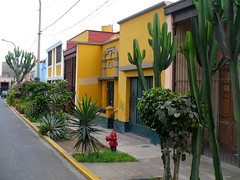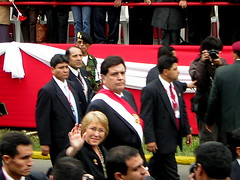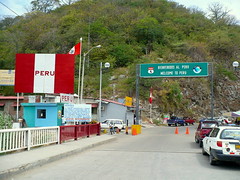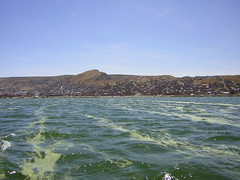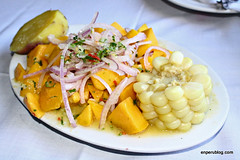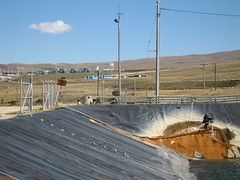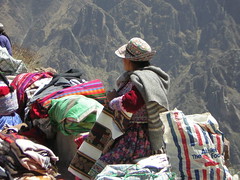With a focus primarily on what Andean communities have contributed to this city’s famous cuisine, Al Jazeera takes a look at street food in Lima.
Category: "Peruvian Food"
Quinoa ‘risotto’ blends traditions of Peru, Italy [Featured]
Marlena Spieler writes in the San Francisco Chronicle about the Andean “grain” called Quinua (Quinoa), and cooking the indigenous food with an Italian twist.
A while ago I popped in to visit James Shenk at his Peruvian restaurant, Destino, in San Francisco. He had promised to teach me how to make a quinoa dish I had tasted at his restaurant.
Entering the kitchen, I found James deep in thought, rubbing his hands together. Was he excited about something? Was he cold? I peered closer and saw that in his hands were tiny seed-like grains, and he was rotating them in a circular motion.
Europeans now allowed to eat Lúcuma
Under the guise of health regulations, the European Union has enforced illegal trade barriers on many developing countries for years. These restrictions blocked certain foods from being imported into the EU if they hadn’t been traditionally consumed by Europeans before 1997.
According to the Directorate-General for Competition, Consumer Affairs and Fraud Repression at the French Economy Ministry, Europe had been unfairly banning lúcuma for years now, as it was indeed marketed in France before 1997.
Who Needs Clubs When Everyone Is at the Cafe? [Featured]
The New York Times recently ran this article about Lima’s cafe and restaurant scene, featuring Gastón Acurio’s La Mar, Sonia’s, and trendy Barranco’s most popular haunts. The first part can be read here
Eating in Lima – What not to miss – Desserts
Part six of what not to miss when eating in Lima.
To say that Peruvians have a sweet-tooth is like saying that fish enjoy being in water. It’s plainly clear and a huge understatement! In fact, Peru is one of only two countries in the world for which Coca Cola was forced to change its traditional recipe in order to make any inroads into the market – they had to make the formula sweeter. Many different desserts are enjoyed across the country and many of them are found in Lima, many of them also originating in Lima.
Eating in Lima – What not to miss – Fast food
Yes, Lima, just like any international city or capital, is afflicted by the curse of US fast food chains. These sprung up after the city was flooded with foreign investment and new prosperity after its dark 80s period. These are of course enjoyed by those who found themselves able to afford to eat in them, but, were they able to kill off home-grown options in the gastronomic capital of the Americas? Not at all.
Eating in Lima – What not to miss – China-Influenced
Part four of what not to miss when eating in Lima.
A boom in Chinese immigration to the Peruvian coast in the 1800s brought with it a new style of cooking and new flavours. Though this meant importing some traditional ingredients, in the majority of cases Chinese families and new Chinese restaurant owners had to make do with local ingredients. This fusion of two culinary worlds created Peru’s famous chifa, the name by which Peruvians call Chinese food.
Peruvian restaurants seize on opportunities abroad
As Peruvian food becomes better known throughout the world, more Peruvian restaurants are seizing on the opportunity to expand into foreign markets. Some have already done this – Pardo’s Chicken is one, and Gastón’s La Mar is another – franchises of famous Peruvian restaurants are now found in the US, Mexico, Venezuela, Colombia and Chile.
Ice cream culture in Peru [Featured]
I recently came across an excellent blog by Ana Otazu, a Peruvian woman from Arequipa who now lives in the UK. She comments on the differences between UK life and Peruvian life in both Spanish and English, attempting to explain these differences to her two audiences. Here she explains Peruvian’s love of ice cream, though leaving out the associated health myths that are widely believed here… perhaps for another blog. 😉
Eating in Lima – What not to miss – Afro-Peruvian
Part three of what not to miss when eating in Lima.
The line that divides the worlds of Creole and Afro-Peruvian food, music and culture generally are ever more blurred together as the melting pot effect takes hold. Black Peruvians contribute heavily to today’s coastal culture which for convenience is often just called “criollo”. What gastro-tourists in Lima are most concerned with though is what Afro-Peruvians brought to the dinner table, and boy did they deliver.
Eating in Lima – What not to miss – Creole classics
Part two of what not to miss when eating in Lima.
Other than sea food, the coastal population in Lima, a mix of Spanish and indigenous descendents known as creoles, have a wide selection of rich-tasting dishes for visitors to try.
Eating in Lima – What not to miss – Seafood heaven
Part one of what not to miss when eating in Lima.
Blessed with a long Pacific coast with some of the richest fishing grounds in South America, Peru’s sea food offerings are outstanding. Lima, birth place of the majority of these dishes, can not be visited without also visiting a cevichería.



